![Roll Player]()
- What a time to be alive! Whilst character creation is perhaps one of the most exciting things about many role playing games, I honestly never thought that I’d see a board game about it. But, Roll Player is just that; a board game that focuses purely on creating optimal characters based on a randomly chosen class, alignment and back story. This is a fast-paced dice game for one to four players and, I tell you what, give it chance and you might be surprised by what it does well.
Overview
Roll Player certainly presents a simple concept that any video or board gamer can get behind. The desire to create an unbelievably powerful character that is perfectly suited to their role is a very strong one among players — unless, obviously, you are the kind of masochist who plays Dark Souls as a “Deprived” class. Roll Player simulates the character creation procedure by using fun, dice drafting mechanics and a strong objective structure that gives players several things to think about.
The game usually lasts around an hour, although it is more like thirty minutes when played solo and perhaps ninety minutes when four players are involved. The solo game is more or less mechanically identical to the multiplayer experience and there is an option to play against an AI who has just a couple of rules tweaks to take into consideration. Overall, Roll Player is fairly straightforward to learn and to teach, especially if the players already understand the basic concept of creating an RPG character.
Broadly speaking, the players will take turns to draft dice and add them into gaps on their player board. Both the dice value and colour can be relevant, since each role requires different attribute values, each of which will be worth victory points. A fighting class, for example, will demand higher scores for strength or constitution, whilst a cleric might seek wisdom. Placing dice of specific colour in the slots indicated on your board will also score bonus points and every time a dice is added to one of the six attributes, a special action can be taken. Dexterity, for example, allows any two dice to be switched.
At the end of the game, each player will look at their class, alignment, background and attributes (and their cash plus any other modifiers) and tally up their score. The highest score across everything wins, rightly suggesting that the winning player has created the ultimate RPG character. There are a fair number of other things to consider in Roll Player, like the purchase of equipment after each round of drafting and the benefits of various special actions.
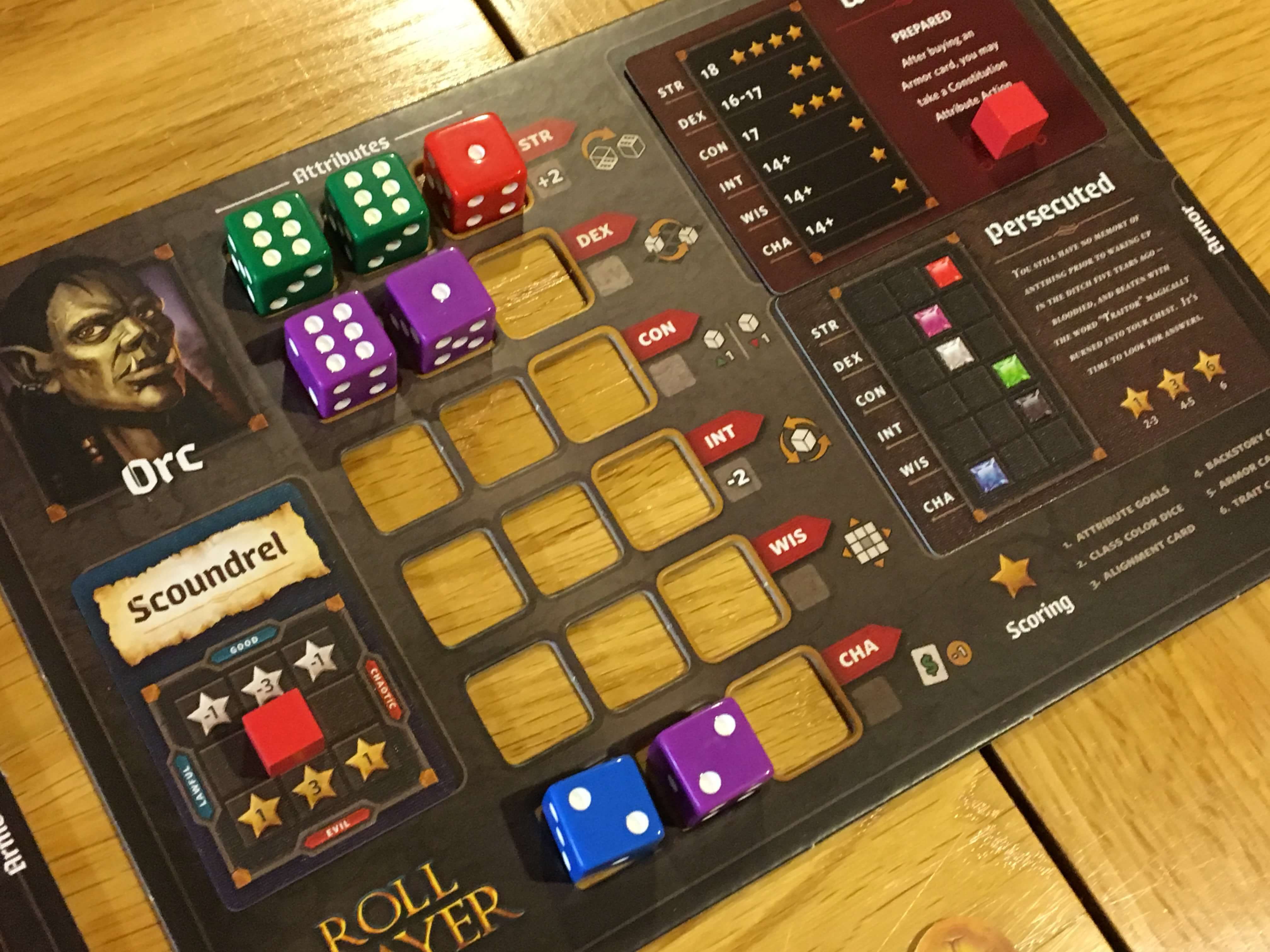
Components
Roll Player is presented in a smallish, compact and impressive package. Very little space inside the box is wasted, thanks largely to the abundance of chunky, attractive dice that come in numerous colors. There are also coin tokens, wooden cubes to track alignment and then a number of decks of cards that aid the randomization of setup, provide the item market and so on. All of this hangs together on the player boards, each of which is double sided and aligned to a particular race (dwarf, human, elf etc.) It’s a nice touch that the designers saw fit to make both male and female sides of each race, so players can choose whatever character they prefer.
The player boards are well made from sturdy cardboard, which means that dice slot straight into them with no trouble and little chance of accidental damage. They are also clearly and logically laid out, with prompts to show where cards will be added and when specific benefits or actions will result from die placement, for example. The cards are equally clear to use and the artwork throughout is perfectly fine, though I guess one might argue that the subject matter (weapons, armor, items) don’t lend themselves to the most exciting scenes.
The real stars of the show are those dice. All of the different colors are bright and bold, with a larger than average plastic construction that is heavy and satisfying to roll. The number of pips on each is clearly printed and a bag is included with the game to make sure that the blind draw aspect of the game is possible without buying additional accessories. Overall Roll Player is a nicely crafted package — nothing about it is over the top or unnecessary, but everything works well together and I don’t think you’ll find any aspect of the build quality to be lacking.
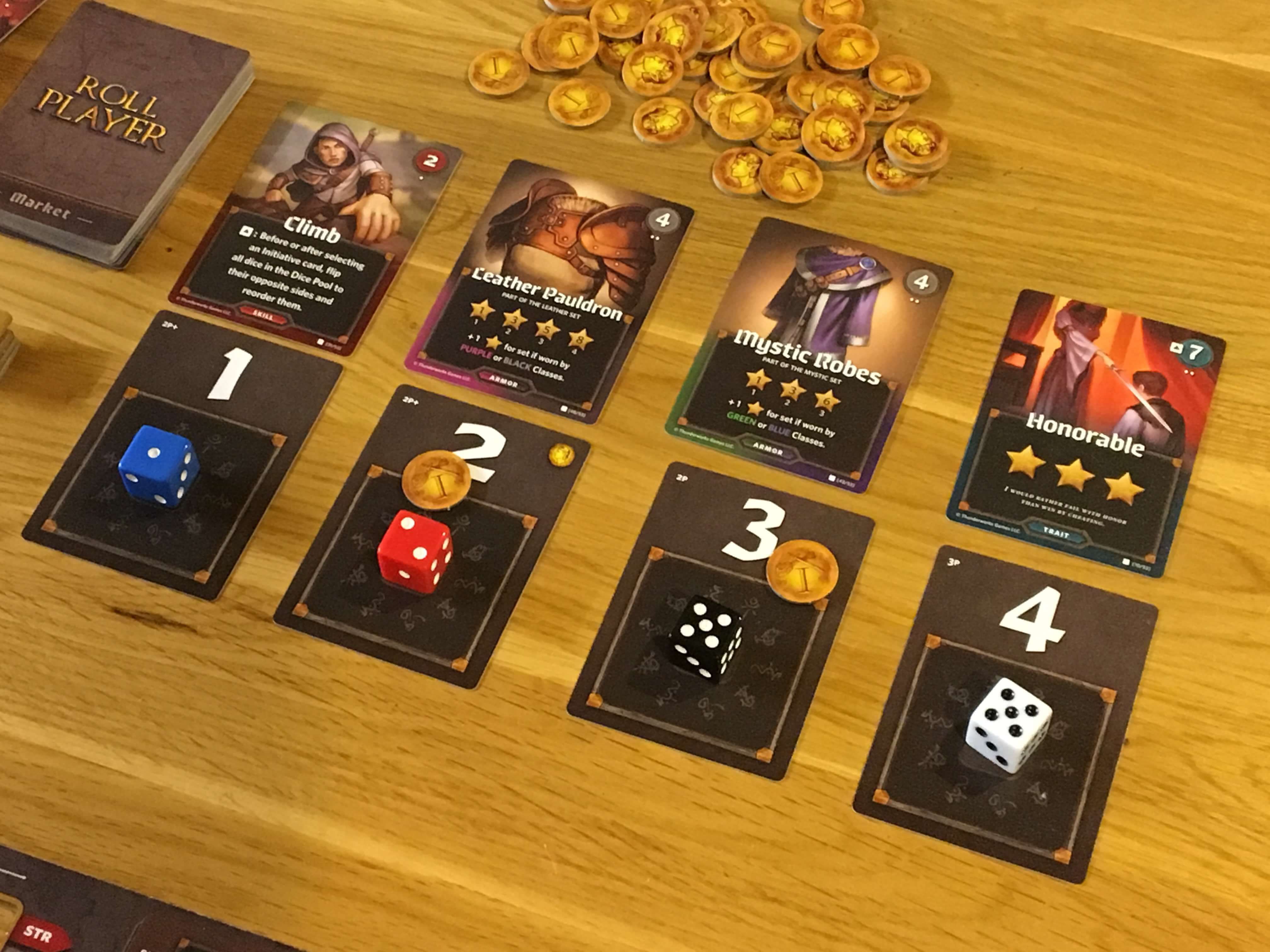
Turn structure
Among the many features that I like about modern tabletop games, one that I consider to be especially important is that of intertwining the player turns so that the game feels permanently engaging. Roll Player achieves this by starting each turn with the lead player drawing one dice for each player, plus one (so three in a two player game) and then placing them on an initiative track from lowest to highest. The players will then take turns to draft those dice, with the highest value ones giving the player who takes them a lower initiative in the buying round that follows. Simply put, taking a higher die will mean you likely miss out on the best item, and vice versa.
When the first player takes their chosen die (and the initiative card it comes with) they will then place it onto their player board. Dice must be placed in the leftmost space of any attribute first and each row takes three dice to fill. Whenever a die is placed, the special bonus for that attribute will also be triggered — for example, the dexterity ability that I mentioned earlier, or the strength one, which allows the player to change the value on one dice. Other effects might be triggered depending on the dice colour, where it was placed and any items the player might have. Sometimes the player will gain money or change their alignment, for example.
Each player will be aiming to draft dice of the right value and colour to manipulate their board until the attribute values are as closely aligned to their class’s ideal specification as possible. This will often be a specific (and high) number for key skills that score the most points, whilst less critical attributes might have a middling requirement and a range of values that will score, albeit that the points awarded will be much fewer than those given for critical skills. Some of the races have a base modifier (elves are dextrous, halflings are weak) which can make it easier, harder or even impossible to fulfill your target value. These factors should be considered carefully when setting up your character.
After the players have all drawn their chosen dice (and the initiative card that comes with it) they may purchase from the market. There are weapons, armour sets, traits and skills to choose from, each of which will work slightly differently. Some of these cards have passive effects that enable the player to influence their dice or attributes somehow, whilst others provide skills that must be activated and allow an immediate benefit. Armour often comes in sets and complete sets are worth large amounts of points.
After the drawing and drafting of dice and then the purchasing round, any cards left in the market will be discarded and any dice will be returned to the bag. A new set of items will then be laid out and the next player will draw dice from the bag and place them, effectively repeating the process. This cycle continues until all players have filled all spaces on their board (effectively eighteen rounds.) Once all the boards are filled, the players use the back of their player aid to track points from all sources — mostly the alignment of attribute values to dice placements.

Game experience
From the perspective of someone who really loves to immerse themselves in the deeper aspects of character creation in games, I have to admit that I feel that Roll Player captures the feeling of creating the perfect character very well. The initial set up of the board (where six dice are drawn and placed anywhere) creates a similar feeling to that which you’ll experience when you create your first crappy D&D character and, at best, you’ll have one or two stats that come even close to where you want them.
As the game goes on, of course, you’ll add more and more dice, but most importantly, you’ll add many skills, items and traits to your character board. I found that this was where Roll Player moved away from the basic character creation element and came into its own. Adding dice and cards to your board is the equivalent of questing and defeating enemies (presumably) to obtain experience and money, but in Roll Player, none of that is seen — players simply draw dice. I’m actually quite pleased about that, because by keeping things simple, Roll Player remains a short, sharp and punchy experience.
Roll Player is a very streamlined game to play and I like that the objective is so straightforward and yet so varied: make the best character you can. Simple. With that said, optimising dice value and placement, managing your alignment and collecting items creates a rich mixture of options to pursue. Obtaining all of these goals is nigh on impossible in a single play, so as with all good games, Roll Player often becomes a case of making tough decisions every single turn, with a real sense of urgency as the board fills up with dice.
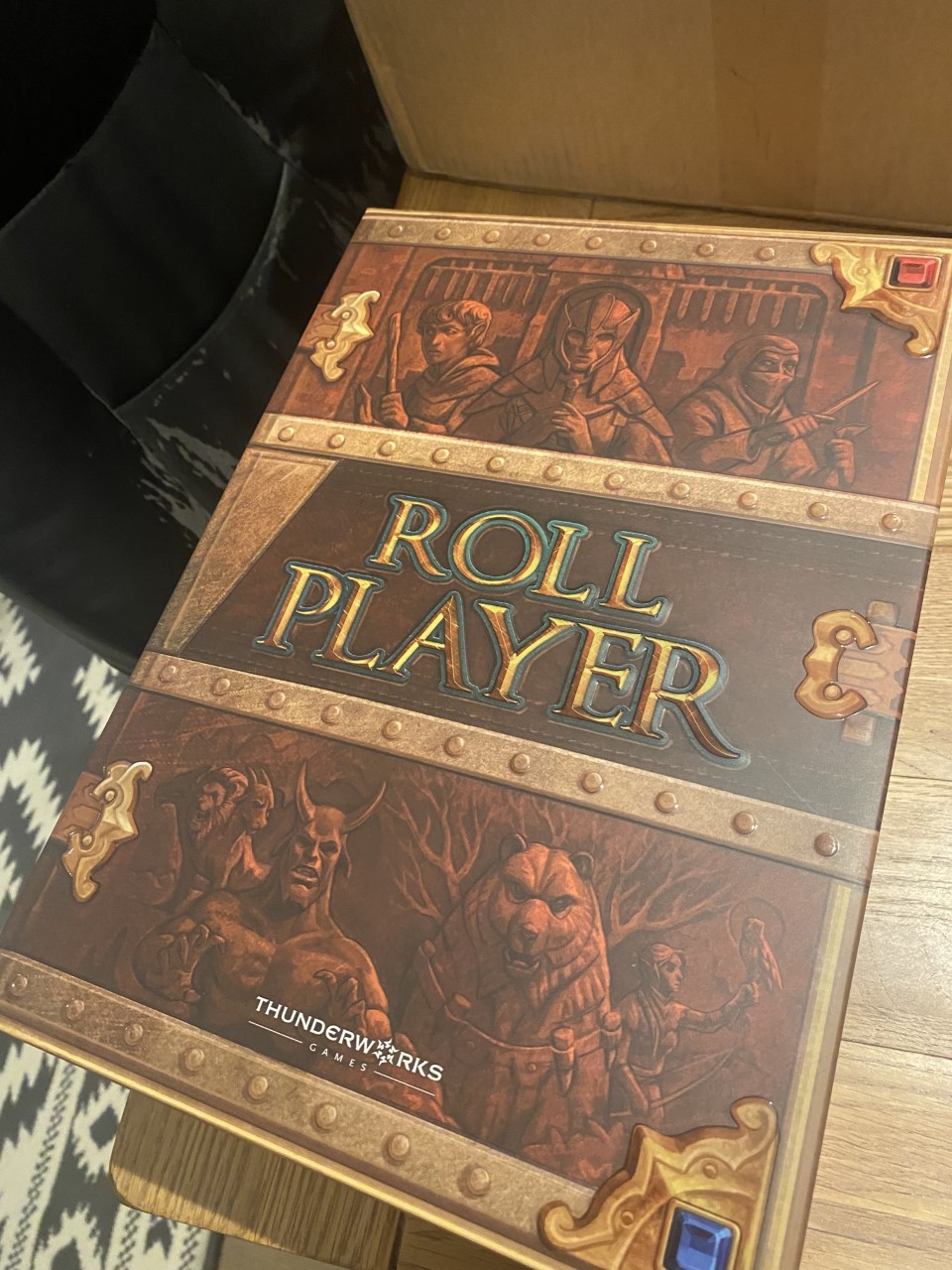
Monsters and Minions Expansion
The first of two current expansions for Roll Player is Monsters and Minions. This expansion introduces a few new concepts that add depth to the existing experience, as well as one or two that broaden the scope to the game. The first of the latter kind of addition is that of a whole raft of additional marketplace cards that add new skills, traits and items to the existing decks. This adds a ton of variety for players who have played the base game a lot, but few of the new cards radically game changing. There are, of course, also a number of additional races, classes and back story cards to play with.
The first of the two titular new additions (Monsters) adds a deck of Monster cards to proceedings. Each of these comes with a Location, an Obstacle and a Raid deck (which is randomised before each game, with only one of each used.) As they build their character in the normal way, players must uncover these L, O and R clues to determine where the Monster will strike, ultimately tracking it down for the final showdown. The main mechanic for assisting in this discovery is the addition of Minions – which reward the players for defeating them with clues, Gold and so on.

The addition of both these Monsters and Minions in this expansion, combat is added. This involves gearing up with new skills and items to add combat dice to your characters pool. The more combat dice; the better your chance of defeating the creatures that you’ll need to face. Thankfully, none of this is rocket science and whilst the addition is a tiny bit wonky thematically (fighting monsters during character creation) it works in terms of how the game flows.
The final material addition to the formula – and perhaps the simplest and best – is that of Boost Dice. These dice come in higher denominations (up to nine) than standard dice, and therefore you can hit those big numbers for your stats. The downside? Each Boost die is colourless, so you can never get the bonus for colour matching. These die work in effectively the opposite way to those dual-colour dice I will describe below, in the Fiends and Familiars paragraph.
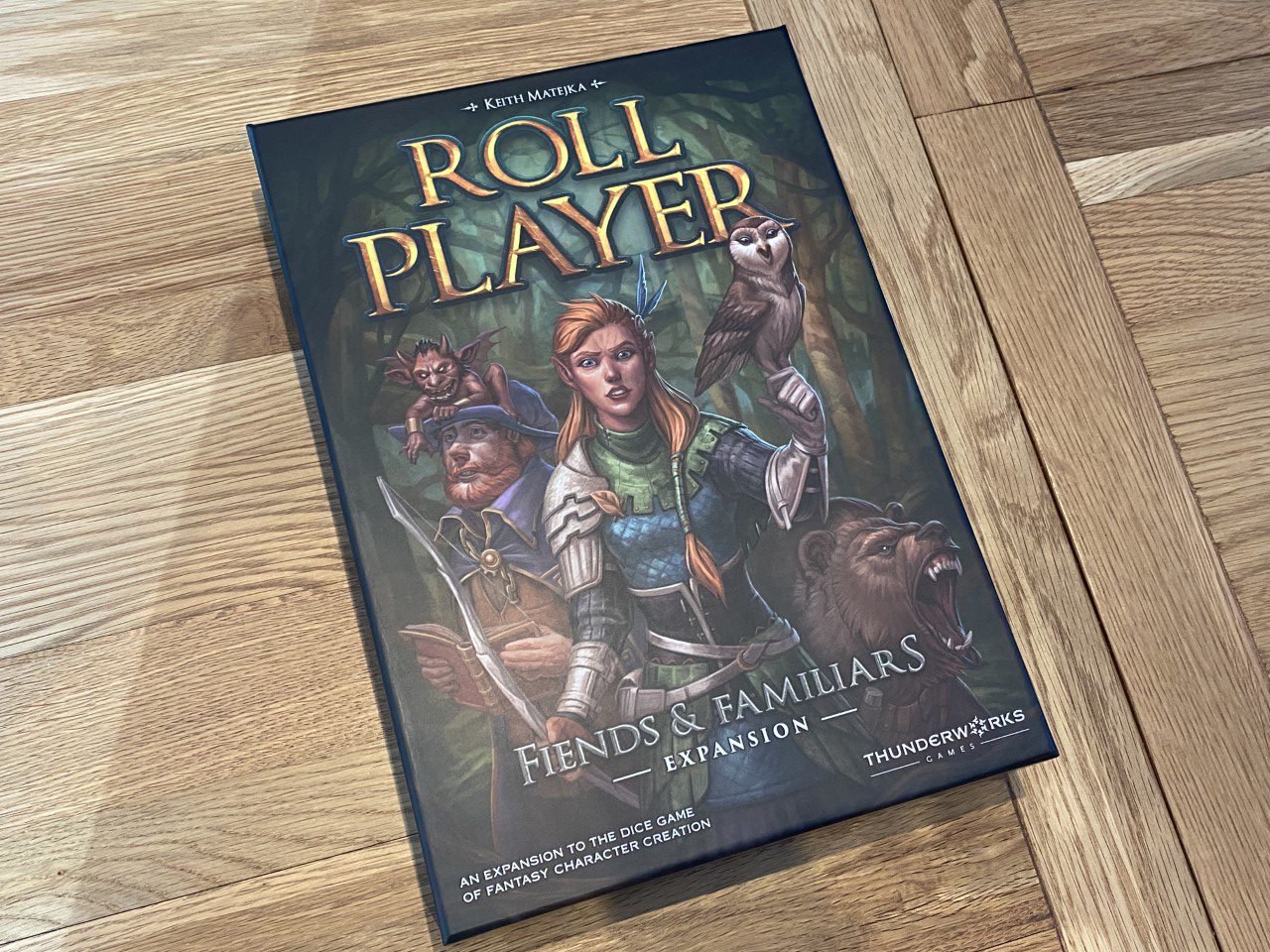
Fiends and Familiars Expansion
Fiends and Familiars is the second expansion for Roll Player and as I often say; board game expansions usually come in two flavours – those that add more of what you love, and those which add something new. It’s also not unusual these days to see expansions which add several modular updates that can be mixed and matched at the behest of the players. Honestly, I think Fiends and Familiars fits all of these descriptions in a way, except that in respect of each of its modules, you sort of need to play with all of them at once.
Fiends and Familiars brings tons and tons to the table in terms of new content. Firstly, there’s the stuff you already know and might wish to see more of – this includes four new races and then a ton of new alignments, classes and backstories. There are also enough new market cards to effectively double the size of the market deck. Whether you combine Fiends and Familiars with the first expansion (Monsters and Minions) or just the base game, the market deck is now to large that a certain number of cards will need to be removed during setup.
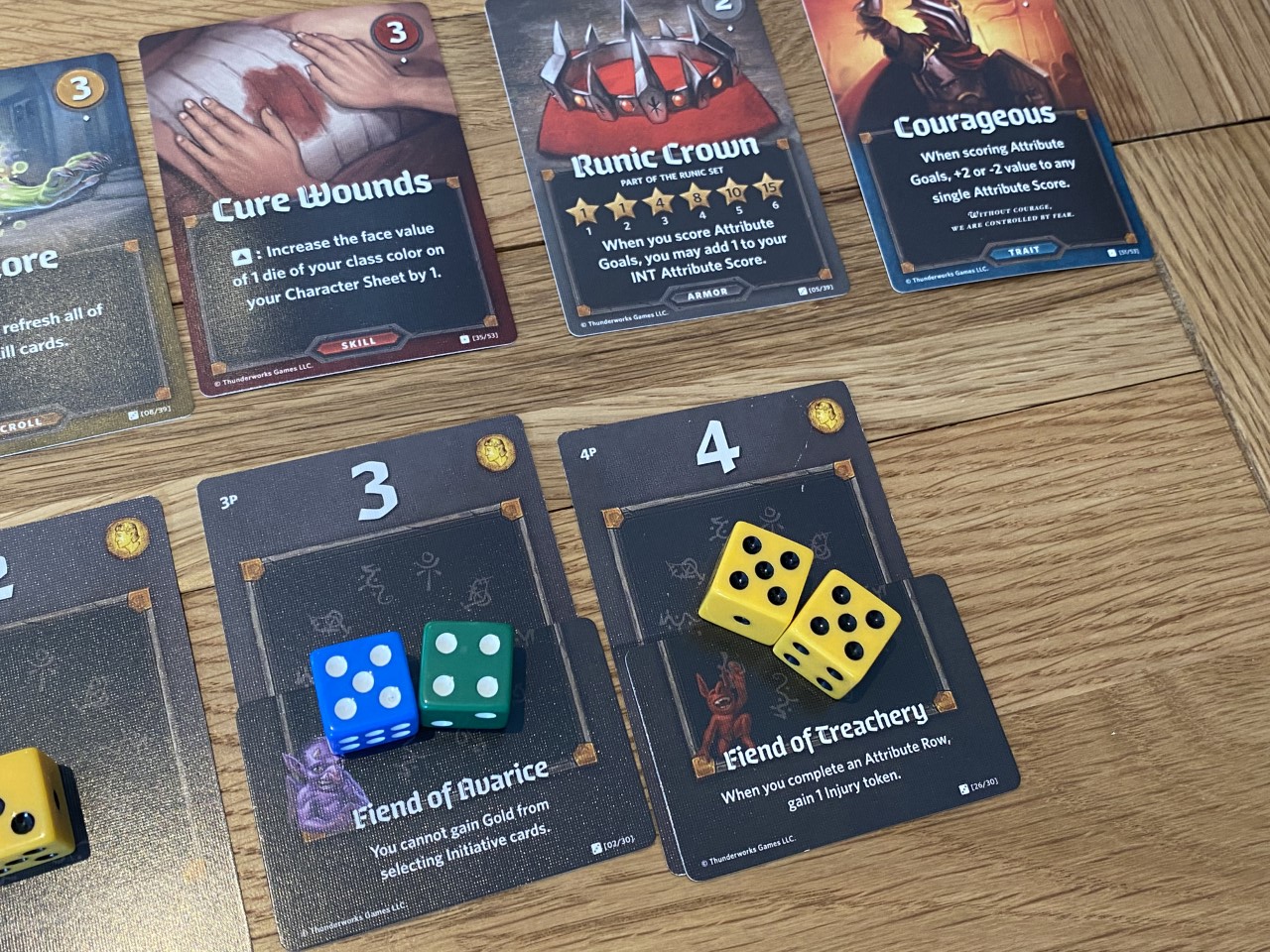
In terms of new content, some of what you’ll get in Fiends and Familiars is net new, whilst some will be seen as new to owners of the base game, or more of the same to owners of Monsters and Minions. There is also some further content that is brand new to Fiends and Familiars, and it is that which I will focus mostly on here. Just briefly on the content that adds to Monsters and Minions, there are now more minion cards to fight (and more combat dice to roll), there are more Scroll item cards (which are basically single use items) and there are more “boss” monster cards along with the adventure cards that come with them. Experience, honour and injury tokens are also common across both expansions.
In terms of what is brand new, Fiends and Familiars adds a new set of player boards known as familiars. There are quite a few of these covering a wide range of mythical beasts from the relatively domestic (Blood Badger, anyone) to the supernatural (various Wyrms and such.) Each one comes with three new dice slots and a power that activates (usually upon placement of a die), plus two ways to score points based on the position of your dice, and the total value.

Now, any experienced player among you might be thinking “but doesn’t that add three more rounds to the game?” And I guess you might be right should you choose to play Fiends and Familiars in the normal way. However, anticipating this, Fiends and Familiars introduces the “Call To Adventure” card, which must not be seeded in the market deck at a certain point depending on player count. Until this card is drawn, each player will draft two dice instead of one with each round, and thereafter, will draft the usual one. Whilst this method results in a bit of extra setup overhead, it also speeds up the early game and makes players feel like they are rewarded earlier – which I like!
Also new to Fiends and Familiars is the inclusion of split dice into the bag. Each of these shows two different colours, but rather than offering values up to six, the most pips you’ll see on any of these is four. In short then, these dice are great for ensuring that you hit your dice placement goals, but they might well cost you in respect of overall score in some of the attribute lines. They are effectively the opposite of the Boost dice that feature in Monsters and Minions.
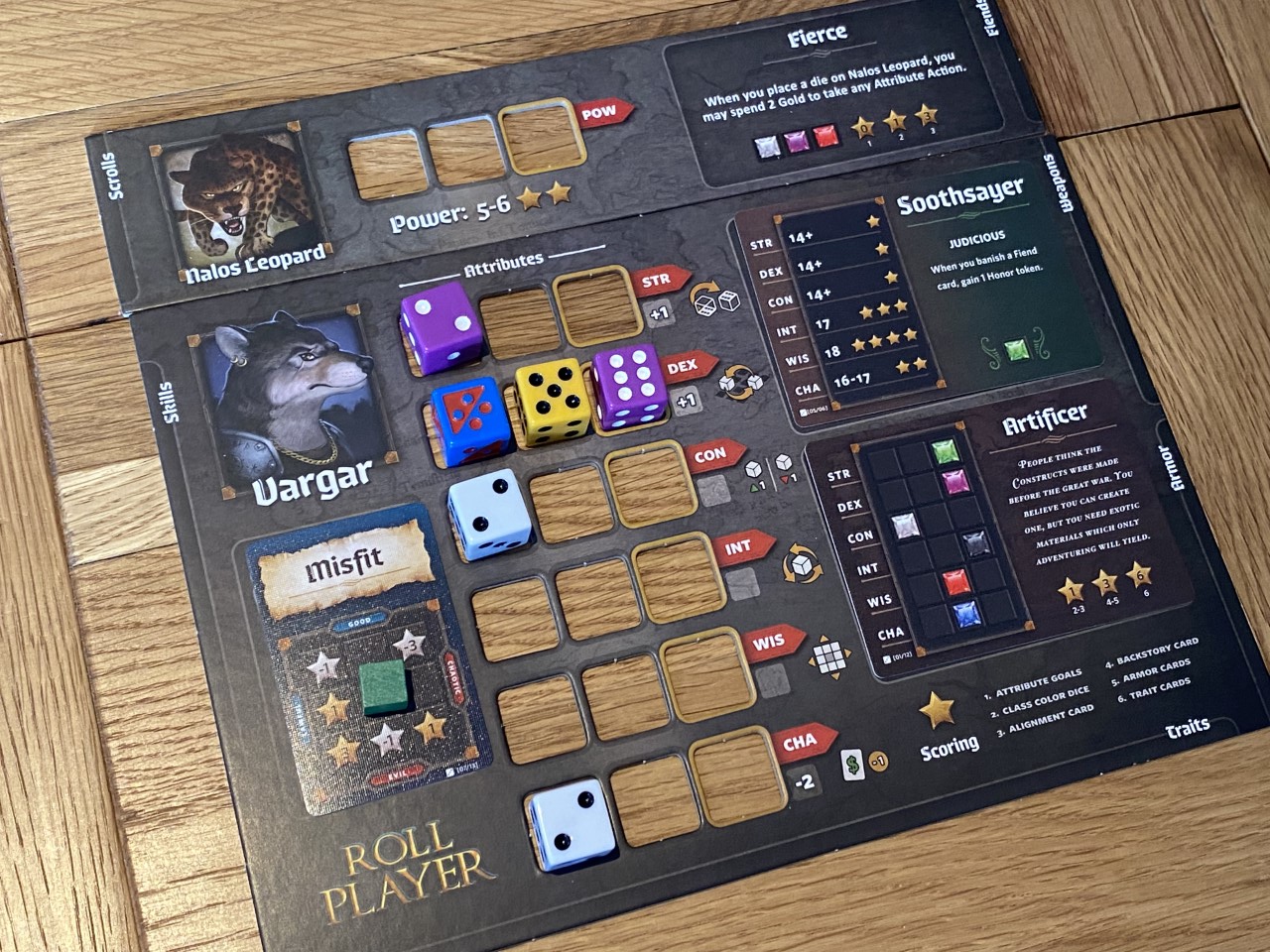
When you lay it all out on the table, Fiends and Familiars brings a lot to the party. Comparing it side by side with the base game, it’s not so much that Fiends and Familiars has more physical mass within the box, but it definitely has a lot more going on. The number of features it introduces is massive, and whilst it helps to have Monsters and Minions in the mix as well, it is by no means necessary in order to enjoy Fiends and Familiars.
For experienced gamers, Fiends and Familiars adds much needed complexity to the simple, highly accessible gameplay of basic Roll Player. In my case, this is almost one hundred percent upside, since as my conclusion below discusses, I do find the base game a little repetitive after repeated plays. The only issue is that the new components are pretty much all or nothing and it’s difficult to imagine how you might add just one or two of the new components (and associated rules) at once. With that aside, Fiends and Familiars is a brilliant expansion that for me is essential for fans of Roll Player.

Conclusion
Roll Player delivers on a lot of the features that I look for in a good game. It plays out in around an hour and each turn passes quickly and with good humour, thanks to the way in which each dice is drafted based on the initiative system. There isn’t a ton of interaction between the players in a mechanical sense, but you won’t miss that given the camaraderie and “banter” that takes place during the drafting. The actual pulling of dice and placement of them is both tactile and appealing both to the eye and to the mind — optimising dice placement to meet multiple objectives at the same time is incredibly satisfying.
I think it is possible to suggest that Roll Player might eventually become a little bit repetitive, but given that the deck of market cards is deep and the variability among races, classes, backstories and alignments is high, I haven’t found myself in that position yet. This is helped by the game length, which means that Roll Player lends itself to short, relatively-deep play perhaps before or after a bigger game. Roll Player adapts very well to different player counts, although I do think it’s a slight shame that it only supports up to four players.
Overall I think Roll Player is a very solid dice drafting and optimisation game that plays quickly and will be of particular interest to people who love role playing games and/or the character creation process that comes with them. Even if you’re not a role playing game fan, I still think that Roll Player creates a complex enough puzzle for others to enjoy, since the concept is very clear and can simply be boiled down into a series of mathematical optimisation exercises. A strong and solid recommendation from me.
A copy of Roll Player was provided for review purposes and can be purchased via 365 Games or through one of the shops found in this handy Store Locator.
